Electric bikes, or e-bikes, are cycles that have an electric motor fitted. They're becoming a popular alternative to the car for daily activities like commuting and shopping, helping to reduce pollution and protect the environment. As technologies advance and prices go down, they're well worth considering when buying a bike. So here's everything you need to know about e-bikes and where to get started.
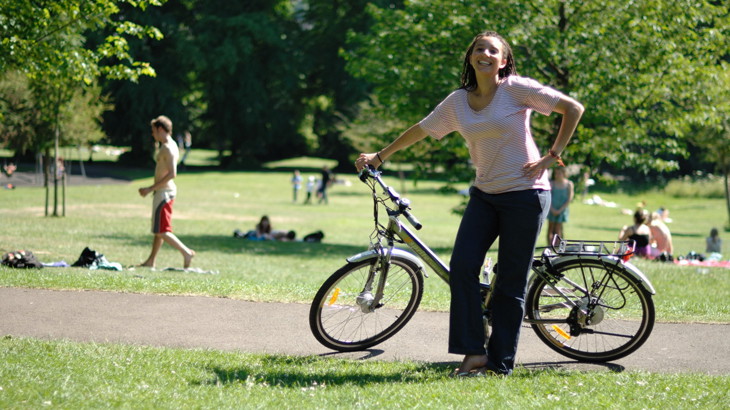
E-bike users travel 64% further than non-e-bike users, according to a recent report from the Netherlands. © J Bewley
As electric bikes become more common on our streets, let's take a look at everything you need to know.
We've got all the answers to your most asked questions about e-bikes:
- What are electric bikes?
- How do e-bikes work?
- The three main types of e-bike motors
- What are the differences between an electric bike and a regular bike?
- Do e-bikes feel different to ride compared to a normal pedal bike?
- Are e-bikes good for exercise?
- What are the rules on e-bikes in the UK?
- Are e-bikes heavy?
- Are e-bikes waterproof?
- Can an electric bike climb hills?
- How far can an e-bike go?
- How long will an e-bike battery last?
- How do you recharge the battery on an e-bike?
- How fast is an e-bike?
- Can I change how much the motor helps me on an e-bike?
- Do electric bikes have gears?
- How much does an e-bike cost?
- Which e-bike should I buy?
- How do I store an e-bike?
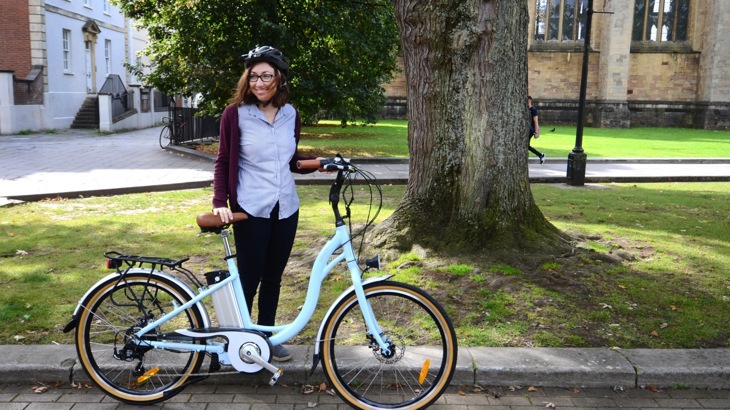
An e-bike can help you go further, for longer. This makes them a great option for commuting to work and doing your shopping.
What are electric bikes?
Electric bikes, or e-bikes, are bikes that have an electric motor fitted. This provides power that can help you with pedalling.
An e-bike can help you go further, for longer, than you might otherwise without motor support.
They are also able to carry larger loads, making shopping even easier.
How much support it can offer depends on the different settings you choose, but you need to pedal for the motor to work.
E-bikes are also equipped with a battery that will need to be recharged between rides.
How do e-bikes work?
In very simple terms an e-bike works by adding oomph when you pedal.
Sensors detect when you are pedalling and the e-bike then supplies extra power via a motor either in the wheels or at the crank.
These sensors can tell how fast or hard you are pedalling and add extra power as you require it.
More expensive e-bikes use torque sensors to tell how hard you are pedalling and then smoothly add the extra power. This is especially helpful on hills or when pulling away at traffic lights.
The energy is stored in a battery, this is usually attached to the rack or the frame. In some e-bikes, the battery is hidden inside the tubes of the frame.
The battery is charged using a charger plugged into the mains, just like a mobile phone.
Batteries do come in a variety of sizes and usually the bigger the battery the further you can go on one charge.
There are 3 main types of motors:
Front-wheel motors
These are located in the hub of the front wheel and are usually found on the most affordable e-bikes.
These motors provide good levels of power for getting around town but are less suitable for very hilly areas.
These motors work with derailleur and hub gears.
Rear-wheel motors
These are often more powerful and quieter than front-wheel motors.
Because they power the rear wheel they usually feel more like riding a conventional bike.
These motors usually only have derailleur gears. And they work well on bikes designed for city and trail riding.
Mid or crank drive motors
These are located by the pedals.
They're usually more powerful and more sophisticated than wheel motors and so can give you more support and deliver it with a more natural feel.
They will work with both derailleur and hub gears.
They're great for all terrains and are ideal for electric mountain bikes.
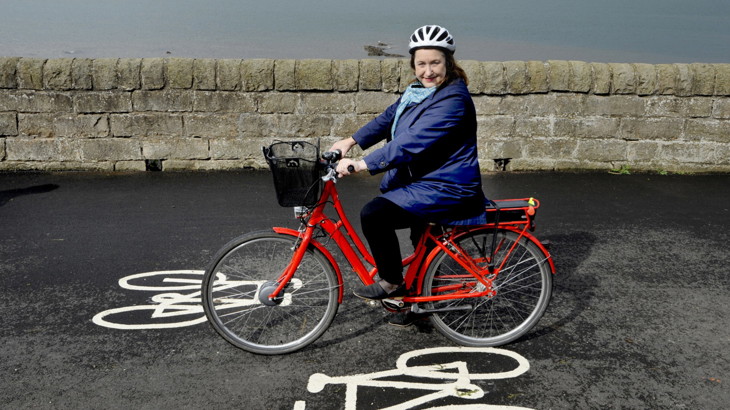
Councillor Lesley MacInness on her eBike at the official opening of the Places for Everyone-funded Lower Granton Way walking and cycling path. ©Colin Hattersley
What are the differences between an electric bike and a regular bike?
So, why would you ride an electric bike, when regular pedal bikes are often much cheaper to buy?
The key differences to consider when looking at e-bikes are:
- E-bikes are often heavier
- How the battery charges
- How an e-bike is stored.
Do e-bikes feel different to ride compared to a normal pedal bike?
Yes and no – it is certainly easier.
You ride an e-bike the same way you ride a normal bike. You might find an e-bike is heavier than a normal bike, but the boost more than makes up for that.
Are e-bikes good for exercise?
E-bikes are a great option for those with lower fitness levels who would like a little assistance.
Equally, they are also suitable for confident cyclists, who would appreciate a boost on long-distance rides.
While the motor assistance of an e-bike may seem like riding one would require little effort, e-bikes are still good exercise.
If an electric bike inspires you to tackle hills or longer rides that you wouldn’t normally, then you’re likely to burn off more energy in the long term.
What are the rules on e-bikes in the UK?
E-bikes are legal in the UK, for those over the age of 14.
Electric bikes are known as ‘electrically assisted pedal cycles’ (EAPCs).
You do not need a licence to ride one and they don’t need to be registered, taxed or insured.
For an e-bike to be legal in the UK it cannot provide power unless you are pedalling, otherwise, it would be an electric motorbike and require insurance and registration.
E-bikes are restricted by how fast they are allowed to go, and can only go up to 15.5mph.
Electric bikes are also subject to the same road laws as other bikes.
For example, it is legal to ride a bike or e-bike on cycle paths and shared-use paths, as well as on the road.
But it is not legal to ride a bike or e-bike on the pavement.
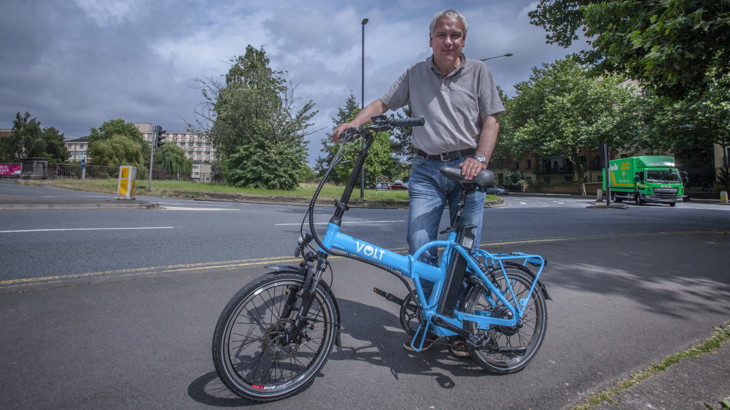
Peter Wise - CEO of Minuteman Press in Bristol - with one of his electric delivery bikes. © Neil Aldridge.
Are e-bikes heavy?
E-bikes are often heavier than non-electric bikes as they have a motor, battery and handlebar-mounted controller, which adds extra weight.
It is always a good idea to check the weight, especially if you expect to need to lift and carry the bike or want to carry it on a vehicle.
A typical weight for an e-bike is over 20 kg. However, as the technology develops electric bikes are becoming lighter, with the lightest currently around 14kg.
And weights will vary between each model of an e-bike, as some will have different types of motors and batteries.
The more power you require in an e-bike, the heavier it will likely be (e.g. eMTB or e-cargo bikes). But road bikes will often remain on the lighter side.
And as technology improves, e-bikes are becoming sleeker and lighter – not dissimilar to pedal bikes.
Are e-bikes waterproof?
Most e-bikes are not completely waterproof. So, for example, you can ride them in the rain, but they shouldn’t be ridden through streams.
Try to take care when cleaning your e-bike too, especially if using a power hose and don’t point the jet at any of the connection points.
Can an electric bike climb hills?
E-bikes are perfect for hills, they provide the extra power to help get you to the top.
They still require you to make some effort though.
And they're often fitted with hydraulic disc brakes.
These are more efficient than normal rim brakes, so be aware that if you pull the brakes hard. You will stop very quickly.
How far can an e-bike go?
There a number of factors that affect this, like hills, wind and how hard you pedal.
It will also depend on the amount of assistance you use.
If the e-bike is on the Eco Setting you might 40-50 miles from a full battery.
If you use the Turbo Setting, this is likely to be reduced to around 30 miles.
How long will an e-bike battery last?
Batteries can last for 25 to 100 miles, depending on which settings you ride with, if the battery is fully charged and how powerful it is.
Note that batteries don’t recharge while cycling on most e-bikes – batteries are much more powerful than they used to be so it’s not necessary.
Instead, you’d recharge the battery between rides.
And if the battery goes flat while out and about? Just pedal anyway, like a normal bike.
It may be harder work to cycle though, so be prepared. Or stay prepared by carrying a charger with you on your journey.
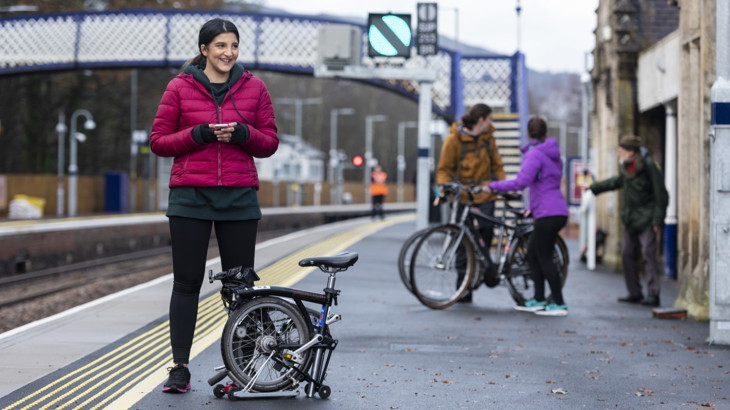
A folding electric bike can be helpful for commuting. ©2019 John Linton.
How do you recharge the battery on an e-bike?
Batteries are better charged indoors, somewhere warm and dry with good ventilation.
It can take from 3 to 10 hours to charge, depending on the model.
Public charging points are installed across the UK, so look out for those for a helpful mid-ride charge.
How fast is an e-bike?
As speeds are restricted by law, the boost will cut out at 15mph (UK and ROI), but you can add to the speed by pedalling faster yourself!
While e-bikes can reach quite high speeds, the point is not a higher top speed, but a higher average speed on your journey overall.
It provides assistance when the journey might be slower: for example going up hills, riding into the wind, and on long-distance rides.
Can I change how much the motor helps me on an e-bike?
Motors can sit in the wheel hubs (hub drive) or in the bottom bracket.
These can offer different riding experiences, with bottom bracket drives being more sensitive.
There will be different assistance levels depending on the model of the e-bike.
But you can often change how much the motor drives the bike, and use the ‘boost’ button for an extra push.
Do electric bikes have gears?
Most e-bikes have gears that are controlled using the levers on the handlebars in the same way you would for a normal bike.
To change gear smoothly just keep pedalling, as you move through the gears using the levers on the handlebar.
For bikes that don't use the derailleur gear change system, you instead will need to release pressure on the pedals and backpedal slightly.
How much does an e-bike cost?
The price of an e-bike can vary depending on the specifications you need.
Typically prices start at £700-£1,000.
Top of the range e-bikes can be over £10,000 but mid-range bikes, £1,500 to £3,000, a usually a great choice for most people
Remember there is more to consider than the upfront cost.
Batteries will need replacing every few years and these can be a few hundred pounds.
Keeping your bike serviced will keep it in better condition in the long run, but the recommended yearly ‘MOT’ may be a cost to factor in.
Of course, e-bikes use electricity to charge and so your electric bills may go up very slightly, but many find it to be a small amount.
Lastly, you’ll want to take out insurance on your bike and pay for good quality security fittings to keep the bike safe.
Insurance options include specialist insurance, which can be expensive or adding the bike to your house insurance (be careful of what is covered).
Insurance policies also often have requirements about where and how a bike is secured at home and what type of bike lock is needed.
Therefore it is worth considering the cost of insurance before purchasing a new bike.
Which e-bike should I buy?
There are many options to consider once you decide to buy an electric bike.
One of which is the type of motor. Motors can sit in the wheel hubs (hub drive) or in the bottom bracket.
These can offer different riding experiences, with bottom bracket drives being more sensitive.
Other types of e-bikes include a folding e-bike which can be handy for commuters.
And e-cargo bikes which are excellent for transporting larger loads, such as your shopping.
Also, consider the position of the battery. Ideally it’s best to have one in the middle as it keeps the weight balanced.
But with batteries becoming smaller nowadays it is becoming less of an issue.
A good tip is to try and test ride different bikes before you buy.
Many councils are offering electric bike hire schemes, where you can hire an e-bike for a week or more.
This is particularly important if you’re looking to share the bike with other people.
Test that it is a nice ride for all of you.
Make sure to give the bike a good test, just like you would with a car.
Test going at different speeds, braking and going up and down hills.
It is best to ask questions and make adjustments to your saddle and reach before you ride away.
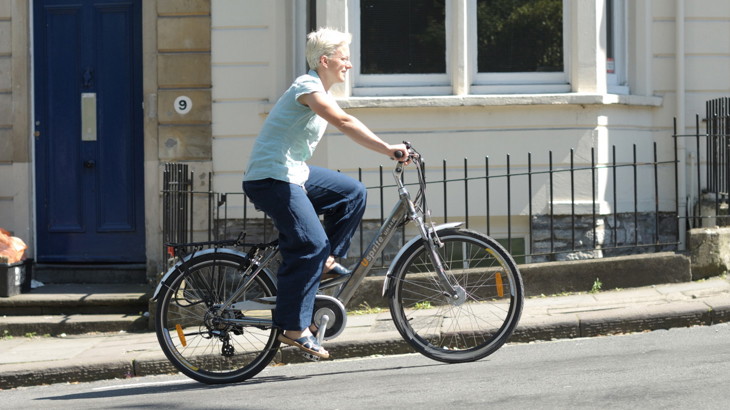
Electric bikes can assist with going up hills. © J Bewley.
How do I store an e-bike?
Similar to a regular bike, storing an e-bike will need careful consideration.
It is best to store electric bikes in a warm and dry environment, so as to protect the battery.
You may also want to be close to a charging point to make recharging easier.
As e-bikes are heavy, you will want to avoid carrying it up and downstairs.
So if you live in a flat it is important to consider where you can store the bike safely and securely.
E-bikes can be parked on a regular bike stand so there’s no need to worry when out and about.
So, are e-bikes worth it?
As technologies advance, electric bikes are becoming a more attractive option when considering a new bike.
For many, it may not be worth the extra money, but for others, it can make all the difference in their cycling experience.
Whether an e-bike is right for you is your decision.
But hopefully, the above advice has given you a little more information to help you decide.
Still not convinced? Here are 9 reasons why you should ride an electric bike.





